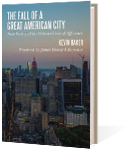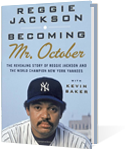Many consider the destruction of New York’s original Pennsylvania Station in 1963 to have been the architectural crime of the twentieth century. But few know how close we came to also losing its counterpart, Grand Central Terminal, a hub every bit as irreplaceable. Grand Central’s salvation has generally been told as a tale of aroused civic virtue, which it was. Yet it was, as well, an affirming episode for those of us convinced that our political culture has become an endless clown-car act with the same fools always leaping out.
“In New York then, I learn to appreciate the Italian Renaissance,” said Le Corbusier of Grand Central. “It is so well done that you could believe it to be genuine. It even has a strange, new firmness which is not Italian, but American.” It was not seen as such by its owner, New York Central Railroad, which viewed it mostly as a cash cow. As early as 1954, the Central proposed replacing the terminal with something called The Hyberboloid — an I. M. Pei monstrosity that, at 108 stories and 1,600 feet, would have become the world’s tallest building at the time. There was enough public outcry that a scaled-down Hyberboloid was built instead just north of Grand Central, where it was retitled the Pan Am (later the Met Life) Building. Even at a lesser height, it proved every bit as grotesque as promised.
Still unsatisfied, New York Central proposed in 1961 to build a three-level bowling alley over Grand Central’s Main Concourse, which would have required lowering the ceiling from sixty feet to fifteen and cutting off from view its glorious blue mural of the zodiac. This, too, was stopped. Foiled again, New York Central resorted to plastering the terminal with ads and bombarding travelers with canned Muzak, complete with commercials, over the public address system.
Meanwhile, in the angry atmosphere that followed the demolition of Penn Station, New York City finally got a Landmarks Preservation Commission, which designated Grand Central a landmark in 1967. But the terminal still wasn’t safe. Now hemorrhaging money as Americans turned away from trains and the passenger rail system began to collapse, the New York Central merged with its old rival, the Pennsylvania Railroad. The chairman and CEO of the new “Penn Central” was one Stuart Saunders, former CEO of the Pennsy, and the man who had torn down Penn Station to build the latest Madison Square Garden.
Bear with us here, as we trace how the troubled new railroad nearly succeeded in tearing down Grand Central — for it says much about how we conduct business and politics in America today.
In his quest to save the new Penn Central, Saunders essentially turned it into a giant holding company. With the merger, the new company had become the nation’s biggest real-estate corporation. Already in possession of the Garden and the New York Knicks and Rangers, Saunders began snatching up others: hotels; pipelines; Arviva, a Florida real estate operation; Six Flags amusement parks; a mobile home company; and a private-plane charter operation.
Of course he wasn’t about to overlook the grandest property he already owned in his quest for cash. In open defiance of the Landmarks Commission, Saunders invited bids for a fresh excrescence just weeks after the commission’s 1967 ruling on Grand Central: a fifty-five-story office tower, to be built on top of the terminal. Some designs for the new building promised to preserve the main concourse, at least, but it was suggested that one side of the terminal might have to be razed in the process.
Who would have been foolhardy enough to encourage a flailing railroad to buy up everything it could get its hands on and enter a protracted legal battle with the City of New York? Pretty much the entire American banking establishment, as it turned out, led by the legendary Walter Wriston, the new president of what was then First National City Bank.
Wriston was an outspoken free-market ideologue who devoted much of his long tenure at City Bank — later Citibank — to rolling back nearly all of the checks and balances placed by the New Deal on the American banking and financial sectors. Rather than try to implement cost-saving measures at one of his largest clients, the new Penn Central, he encouraged it to grab whatever it could, organizing on its behalf a fifty-three-bank syndicate that provided the “railroad” — if it could still be called one — with a $500 million revolving credit line.
When it came to Grand Central, though, Saunders didn’t get what he wanted. In 1969, the Landmarks Commission, to its everlasting credit, voted unanimously to deny Penn Central permission to disfigure the terminal. Then the railroad sued.
The company also had the unmitigated chutzpah to argue that Grand Central’s aesthetic quality had been diminished because it was now “set against the backdrop and contrasting lines of the Pan Am Building, which appears to hang over the terminal and to dwarf it.” That’s right: the Penn Central actually argued that an awful building it had forced on the cityso degraded Grand Central that the terminal could be partially or fully razed in favor of another awful building.
The commission’s rulings were unconstitutional, Penn Central argued, because they went, “beyond the scope of any permissible regulation and constitute[d] a taking of plaintiff’s private property for public use without just compensation.”1 This appeal to the takings clause of the Bill of Rights has since become a pillar of right-wing thought, but it was no easy sell in 1969 New York. The railroad found the right judge in Justice Irving H. Saypol of the New York State Supreme Court.
Saypol’s judgeship had been a reward for his successful prosecution in 1952 of Julius and Ethel Rosenberg on charges of conspiracy to commit espionage. Sitting now in judgment of New York’s most magnificent building, he found it lacking. In January 1975, he ruled that Penn Central had indeed suffered an unfair “taking” of its property — a ruling that threatened to invalidate New York’s landmarks law altogether. He also agreed with the railroad’s lawyers that Grand Central had little or no remaining aesthetic value, and said that it evoked “no reaction here other than that of a long neglected faded beauty.”
Saypol’s aesthetics aside, taking from whom? By the time the judge’s ruling came down, the Penn Central Railroad didn’t really exist anymore and hadn’t for years. Some $100 million of its debt had come due in 1969 and 1970, when Wall Street had hit a downturn and the country was in the midst of a credit crunch. The banks Walter Wriston had organized to support Penn Central were the first to bail. Rumors of insider trading abounded. Economist and securities analyst Alan Lechner explained the railroad’s downfall in his 1980 book, Street Games:
A lot of banks had lent money to Penn Central. A lot of banks had trust departments that were heavily invested in Penn Central stock. It is illegal to trade on insider stock, but when serious trouble began to show at the railroad, you can be sure that the bankers were the first to know about it — in their role not as trust officers but as lending bankers . . .
[W]hat happened to Chase Manhattan Bank, Morgan Guaranty Trust, Continental Illinois National Bank and Trust, and all the others when Penn Central began to go? You bet. Their trust departments sold massive amounts of the company’s stock. Put it out on the market for us investors to buy up. There had been some talk circulating in the Street about difficulties with Penn Central. Nothing serious. But these banks unloaded.In other words, the banks sold investors stocks they knew were about to collapse in order to save their own investments — a practice Americans became very familiar with in 2008.
Within a year, Penn Central’s stock price had dropped from $85 to $15 a share, with the suckers taking all the losses and First National City Bank left holding the bag. For at least a fleeting moment, Walter Wriston must have thought that those New Deal firewalls he had assiduously chipped away at for so many years had something to recommend them after all. But faced with disaster, the great champion of the free market did not flinch: he ran straight to the government.
Appealing to the Nixon Administration on grounds of national security, Wriston asked for a $200 million Defense Department loan to Penn Central and a bailout package of $750 million for all of the nation’s railroads. Spooked by the growing unease on Wall Street, Nixon tentatively agreed, but the Democratic Congress said no.
Penn Central went under. With $6 billion in assets, it was at the time the largest U.S. corporation ever to go bankrupt, and the first major corporation to fail since the Great Depression.
None of the bankers suffered any consequences. The Federal Reserve simply struck down another New Deal regulation, allowing the banks to increase their interest rates while the Fed pumped $676.3 million in loan guarantees into the banking system. Congress, meanwhile, consolidated most of the nation’s passenger railroads into Amtrak and authorized some $7.7 billion to turn Penn Central and five other railroads into the combined passenger–freight company known as Conrail.
Conrail would start to make money by 1981. The feds earned a $579 million dividend in 1987 and sold off the company; its services were divided into a freight subsidiary and several state-run local passenger lines in the Northeast. By 1983, the passenger lines in and out of Grand Central were being operated under the name Metro-North by the state of Connecticut and the Metropolitan Transit Authority (MTA), which remains the case to this day.
So what does this have to do with saving Grand Central Terminal?
Well, while his railroad had been saved by the public, Walter Wriston had got himself into another fine mess. In 1960, a New York bond attorney by the name of John Mitchell had come up with the idea of a new sort of financial instrument, known as a “moral obligation bond.” Unlike every other bond previously known, the moral-obligation bond was not backed by any government treasury or promise of future revenues, such as tolls on a highway — only by the “moral obligation” of the state to pay them.
Mitchell’s invention was overshadowed by his tenure as Nixon’s attorney general — and by the prison sentence he received for his role in Watergate. But Robert Moses, the “Master Builder” of New York, found moral-obligation bonds ideal for one of the many largely unaccountable public authorities he was still controlling, the Urban Development Corporation (UDC). Wriston and other leading bankers were happy to underwrite and sell UDC bonds, supported as they were by Moses, the New York state legislature, Governor Nelson Rockefeller, and Nixon’s secretary of housing and urban development, George Romney, in a worthy effort on all of their parts to build more public housing.
But by February, 1975, Moses, Nixon, and Romney were all retired, and Rockefeller was moldering away as Gerald Ford’s vice president. UDC held over $1 billion in outstanding moral-obligation bonds, and had only some half-finished public-housing developments to show for it, with no revenue coming in. Wriston led his fellow bankers to a meeting with Governor Hugh Carey, who had been inaugurated just a few weeks before. Hoping to buy time and maybe get a bridge loan until he could cobble together a solution, the bewildered new governor asked Wriston for advice. Seymour P. Lachman and Robert Polner describe the scene in The Man Who Saved New York:
“When Carey asked the nation’s leading underwriters if any had advice for him on how to get through a period of difficulty, Wriston glared at Carey.
“Yes, I do, Governor,” he said tersely. “Pay your debts.”
On February 25, 1975, UDC became the first large government agency in America to default since the Great Depression. The contagion that ensued on Wall Street soon threatened to bankrupt the entire city. But in another meeting with Carey, in May 1975, Wriston and his fellow bankers once again adamantly refused to help.
The threat of bankruptcy directly jeopardized New York’s ability to appeal Judge Saypol’s ruling in the Grand Central case, and in turn to defend the city’s landmark laws. Here the battle to save the terminal went right through the looking glass. The Penn Central Railroad no longer really existed, but its government-subsidized successor stood to win its battle to mangle one of mankind’s greatest achievements by default, because the man who had allowed the zombie railroad to make its ruinous acquisitions, Walter Wriston, now had the city on the ropes thanks to his own reckless investments.
Like something out of Dickens, the spectral Penn Central was still alive in court, claiming that the Landmark Commission’s delays had already cost it $60 million. A lost appeal could result in much higher damages. Mayor Abe Beame feared that this would be ruinous for the city, and was reportedly on the verge of letting Grand Central be demolished or mutilated when civic virtue came riding at last to the rescue.
As Sam Roberts recounts in Grand Central: How a Train Station Transformed America, Brendan Gill wrote a passionate defense of Grand Central in his New Yorkerarchitecture column, while attorneys Nina Gershon and Dorothy Miner fought for it in court, and the Municipal Arts Society and other preservationists rallied leading politicians, celebrities, and cultural leaders to save the terminal. But one voice stood out above all.
“Jackie Onassis will save us,” predicted architect Philip Johnson near the beginning of the campaign, and he proved to be right. The former First Lady made an eloquent handwritten plea to Mayor Beame, invoking President John F. Kennedy’s preservation efforts in Washington and asking about New York, “Is it not cruel to let our city die by degrees, stripped of all her proud monuments, until there will be nothing left of all her history and beauty to inspire our children?”
The City of New York decided to appeal, and an appellate court overturned Judge Saypol’s decision by a 3–2 vote. The railroad carried out its own appeal, first to the highest court in New York state, where it lost again, and then to the U.S. Supreme Court where, on June 26, 1978 — some eight years after Penn Central went bankrupt, and more than seven years since it had ceased to exist — a 6–3 decision in favor of New York City’s Landmark Law finally put a stake through the company’s heart.
Bird’s-eye view of the remodeled Grand Central Station, from the balcony of the Manhattan Hotel. Harper’s Weekly, 1900. Courtesy Library of Congress Prints and Photographs Division
Grand Central was saved. Though in a sign of things to come, Justice William Rehnquist, writing for the minority, sneered, “The City of New York, because of its unadorned admiration for the design, has decided that owners of the building must preserve it unchanged for the benefit of sightseeing New Yorkers and tourists.”
Yes, it was true. A great city had decided that a profoundly beautiful and useful building might be preserved against the claims of stock jobbers and confidence men, and of an impecunious transportation entity that had already thrown itself at the mercy of the public weal.
Eventually, of course, Rehnquist and the other clowns would come to run the circus. First, though, Saypol would be charged with bribery and perjury for a scheme to steer appraisal and auction commission funds to his son. (He received a fairer hearing than the people he railroaded to the death house, and the charges were dropped shortly before his death from cancer.)
Governor Carey later turned to President Ford for the federal loans and guarantees that Wriston and the nation’s leading bankers had refused him. He was denied again, because Ford’s chief of staff, a native of Illinois, had consulted with Mayor Richard Daley Sr., and agreed with him that if the nation’s largest city went bankrupt, it would be a good thing — for Chicago. The name of Ford’s chief of staff was Donald Rumsfeld.
Carey turned instead to Albert Shanker and his much maligned United Federation of Teachers union for the nearly $500 million needed to keep New York afloat. He got the money. The city was saved by the further sacrifices — the cutbacks and the layoffs — endured by its municipal workers and its other citizens.
Ford eventually came around with the loan guarantees necessary to let the city borrow again, but only after intense pressure from Congress and European governments — and after his chief of staff’s assistant, an ambitious young draft dodger named Dick Cheney, made the city agree to end free tuition at the City University system — something it had provided through war, recession, and municipal malfeasance since 1847.
Ford’s turnaround was too late to save his 1976 election campaign, when he lost New York — and the national vote — by just four percentage points. But his underlings, Rummy and Cheney, survived and went on to long careers of public service, as did Rehnquist, the man who regarded Grand Central Terminal as a sightseeing gimmick.
Walter Wriston would die just a few years short of seeing his vision come to fruition in 2008: a world of largely unregulated banks and financial firms, free to bring the world economy to its knees before turning to the government for a bailout that dwarfed his old record with the Penn Central. The circus never closes.









